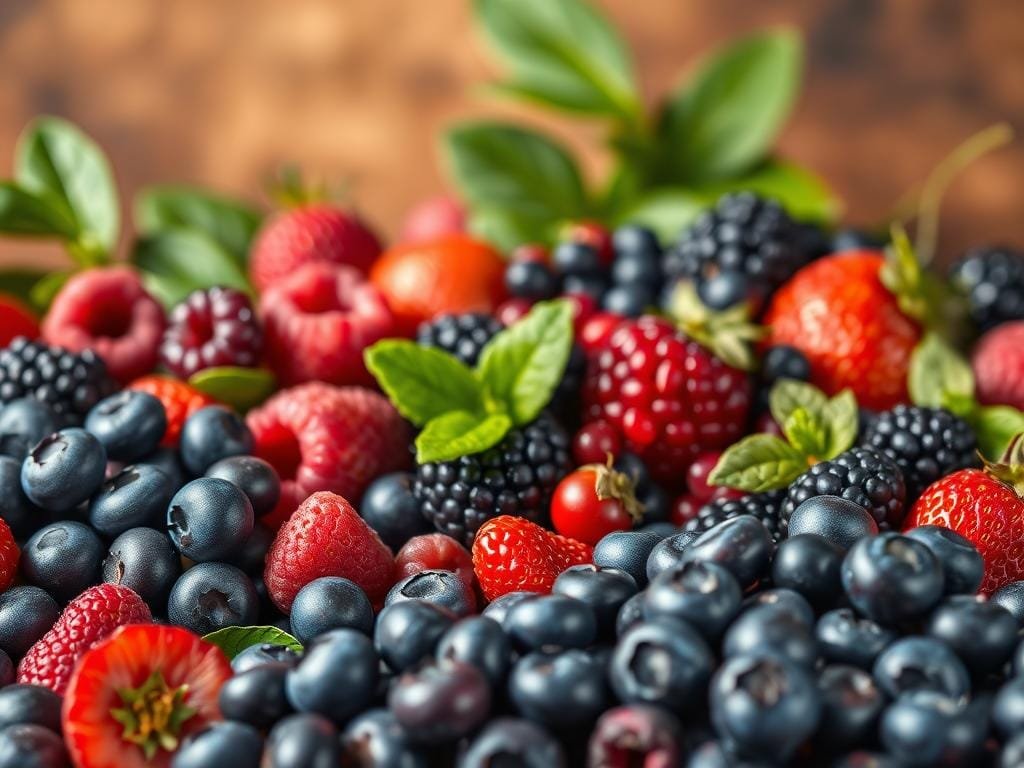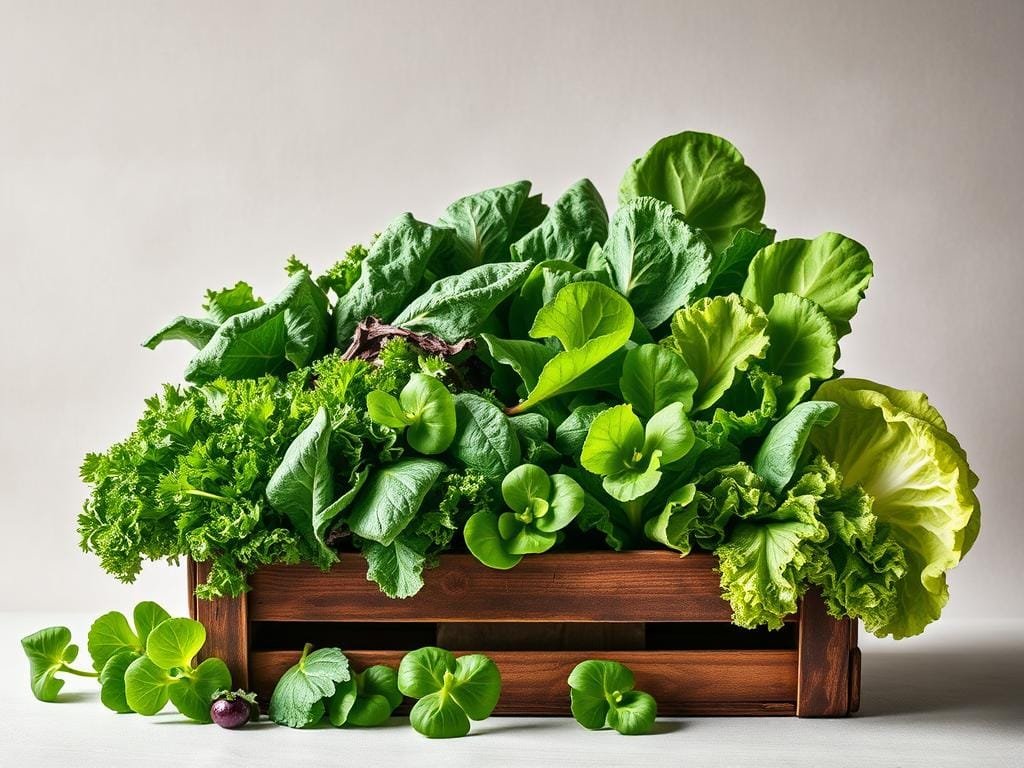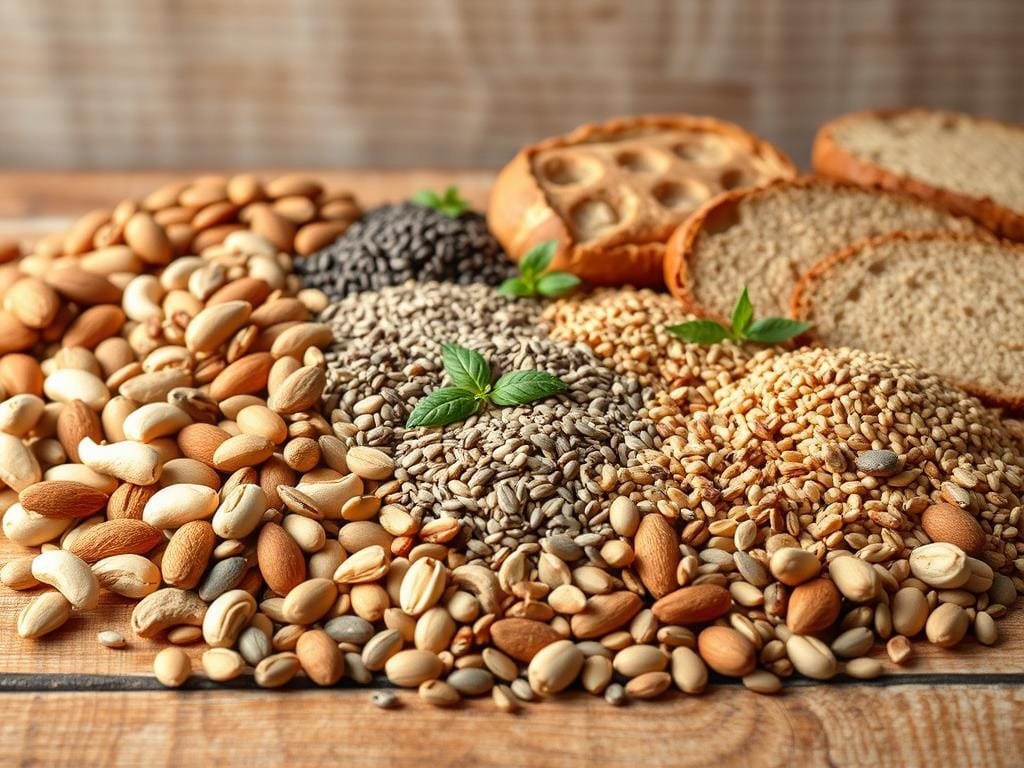Did you know that adding nutrient-rich foods to your diet can greatly improve your health? There are so many superfoods out there, making healthy eating easy. From acai berries full of antioxidants to zucchini’s versatility, superfoods offer a wide range of options.
Exploring potent superfoods opens up a world of possibilities for your diet. This guide will show you the benefits and special qualities of different superfoods. It will help you make smart choices for your healthy eating path.
Table of Contents
Key Takeaways
- Discover the benefits of incorporating superfoods into your diet
- Explore a variety of nutrient-rich foods from around the world
- Learn how to use superfoods to enhance your overall health and wellbeing
- Understand the unique properties of different superfoods
- Get started on your healthy eating journey with our comprehensive guide
What Makes a Food “Super”?
The term ‘superfood’ is popular in health and wellness. But what makes a food truly ‘super’? Exploring nutrient-rich foods reveals key traits that distinguish them.
Defining Characteristics of Nutrient-Dense Foods
Nutrient-dense foods, or superfoods, are packed with vitamins, minerals, and antioxidants. They are rich in:
- Antioxidants: These protect cells from damage, possibly lowering disease risk.
- Essential Vitamins and Minerals: Vital for health, they support the body and wellness.
- Phytochemicals: Plant compounds with health benefits, like fighting inflammation and cancer.
The Science Behind Superfood Benefits
Science supports the health perks of superfoods. Research shows they boost health, from immune support to disease prevention.
Some key findings are:
- Berries and greens’ antioxidants may cut oxidative stress and inflammation.
- Fatty fish and nuts improve heart and brain health.
- Turmeric and ginger’s phytochemicals fight inflammation.
Knowing what makes a food ‘super’ helps you choose better for your health and wellness.
The World’s Most Potent Superfoods: An Overview
Exploring superfoods opens a world of history and benefits. These foods have been key in traditional diets. They offer a high dose of nutrients for better health.
Historical Perspective on Superfoods
Superfoods have been used for centuries. Indigenous Amazonians eat acai berries for antioxidants. In Asia, seaweed is rich in minerals.
These foods were linked to long life and energy. They were eaten during hard work or when extra nutrition was needed. Today, we value these foods for their health perks.
Modern Superfood Research and Discoveries
Recent studies confirm superfoods’ health benefits. For example, natural supplements like superfoods boost health when part of a balanced diet.
- Antioxidant-rich foods like berries and greens fight oxidative stress.
- Omega-3 rich foods like chia seeds and fish are good for the heart.
- Adaptogenic herbs like ashwagandha and rhodiola help with stress.
These findings have made superfoods popular. They’re now part of many diets through various products and recipes.
How Superfoods Support Overall Wellness
Superfoods offer essential nutrients, vitamins, and minerals. Adding them to your diet boosts health. They support the immune system and increase energy.
Superfoods’ benefits include:
- Increasing antioxidants to protect cells.
- Improving heart health with omega-3s and more.
- Boosting digestive health with fiber.
Knowing about superfoods’ history, research, and benefits helps you choose them wisely. This way, you can improve your overall health.
Berries and Fruits: Nature’s Antioxidant Powerhouses
Nature has given us many antioxidant-rich berries and fruits. These are known as superfoods because they are very nutritious. They taste great and are good for your health, making them a great choice for a balanced diet.

Açai: The Amazonian Purple Gem
Açai berries are famous for their deep purple color and lots of antioxidants. They come from the Amazon rainforest and have been eaten by indigenous people for a long time. Açai berries are full of fiber, vitamins, and minerals, which is why they’re loved by health fans.
Blueberries, Goji, and Other Antioxidant-Rich Berries
Blueberries and goji berries are among the top berries for antioxidants. Blueberries help improve memory and thinking, while goji berries fight inflammation. Other berries that are rich in antioxidants include:
- Raspberries
- Strawberries
- Cranberries
Tropical Superfruits: Mangosteen, Dragon Fruit, and Jackfruit
Tropical fruits like mangosteen, dragon fruit, and jackfruit are not only unique but also full of nutrients. Mangosteen is full of vitamins and minerals, dragon fruit is rich in vitamin C, and jackfruit is a great source of fiber and potassium. These fruits are a tasty way to add more antioxidants to your diet.
Everyday Fruit Superfoods: Apples, Citrus, and Pomegranates
Fruits like apples, citrus fruits, and pomegranates are also superfoods because of their high nutritional value. Apples are full of fiber, citrus fruits are packed with vitamin C, and pomegranates are loaded with antioxidants. Adding these fruits to your daily meals can bring many health benefits.
In conclusion, berries and fruits are key to a healthy diet, giving us essential antioxidants, vitamins, and minerals. By eating a variety of these foods, you can enjoy many health benefits and support your overall well-being.
Leafy Greens and Vegetables: The Foundation of Health
Leafy greens and vegetables are full of vitamins, minerals, and antioxidants. They are key to a healthy diet. These foods support our health and lower the risk of chronic diseases.
Kale, Spinach, and Other Nutrient-Dense Greens
Kale and spinach are superfoods, rich in vitamins A, C, and K. They also have minerals like calcium and iron. You can add them to salads, smoothies, or sauté them as a side dish. For more info, check out Summa Health’s article on leafy greens.
Cruciferous Vegetables: Broccoli, Brussels Sprouts, and Cabbage
Broccoli, Brussels sprouts, and cabbage are great for fighting cancer. They also support detoxification and immune function. Adding them to your diet is a smart move.
| Vegetable | Nutrient Content | Health Benefits |
|---|---|---|
| Broccoli | Rich in Vitamin C and Fiber | Supports immune function and digestive health |
| Brussels Sprouts | High in Vitamins C and K | Boosts immune system and bone health |
| Cabbage | Rich in Vitamin C and Antioxidants | Supports immune function and reduces inflammation |
Root Vegetables: Sweet Potatoes, Beets, and Turnips
Sweet potatoes, beets, and turnips are packed with vitamins and minerals. Sweet potatoes are full of vitamin A. Beets are good for heart health because of their nitrates.

Zucchini and Other Squash Varieties
Zucchini and other squash are low in calories but high in nutrients. You can grill, sauté, or spiralize them for a tasty dish.
Eating a variety of leafy greens and vegetables boosts your health and well-being.
Seeds, Nuts, and Grains: Concentrated Nutrition
Adding seeds, nuts, and grains to your meals boosts your health. They are full of healthy fats, protein, and fiber. These nutrients make them great for your diet.

Chia, Flax, and Hemp: The Omega-3 Powerhouses
Chia, flax, and hemp seeds are loaded with omega-3 fatty acids. These are good for your heart and brain. You can add them to smoothies or salads.
For example, mix chia seeds with almond milk and honey for a healthy pudding. To find more healthy recipes, check out healthy food recipes online.
Nuts: Walnuts, Almonds, and Brazil Nuts
Nuts are tasty and full of nutrients. Walnuts, almonds, and Brazil nuts are top choices. Walnuts have antioxidants, almonds have vitamin E, and Brazil nuts have selenium.
Ancient Grains: Quinoa, Amaranth, and Teff
Quinoa, amaranth, and teff are ancient grains full of nutrients. Quinoa is a complete protein, amaranth is high in calcium, and teff is rich in iron. You can use them in salads or main dishes.
| Food | Protein Content | Fiber Content | Healthy Fats |
|---|---|---|---|
| Chia Seeds | 5g | 10g | 9g |
| Walnuts | 4g | 2g | 18g |
| Quinoa | 8g | 5g | 4g |
Superfoods from the Sea
Marine superfoods, like seaweeds and seafood, are full of nutrients. The ocean is a treasure trove of foods that can boost your diet and health.

Seaweeds: Spirulina, Chlorella, and Kelp
Seaweeds are some of the most nutrient-rich foods around. Spirulina, chlorella, and kelp are loaded with vitamins, minerals, and antioxidants. Spirulina, for example, is high in protein and boosts energy and immune function.
You can add spirulina to smoothies or take it as a supplement. For more on marine vegetables’ health benefits, visit this resource.
Fatty Fish: Salmon, Mackerel, and Sardines
Fatty fish are also marine superfoods, rich in omega-3 fatty acids. These are key for heart and brain health. Salmon, mackerel, and sardines are great sources of these fats.
Eating these fish can lower inflammation and improve heart health. You can grill or bake them for tasty, healthy meals. For recipe ideas, check out this blog.
Shellfish: Oysters, Mussels, and Clams
Shellfish like oysters, mussels, and clams are tasty and nutritious. They’re full of protein, vitamins, and minerals like zinc and iron. Adding them to your diet can support your immune system and overall health.
They’re versatile and can be used in soups, salads, and main dishes.
Herbs, Spices, and Medicinal Plants
For centuries, people have used herbs, spices, and medicinal plants for their health benefits and flavor. These natural wonders are key in traditional medicine and modern health.
Turmeric, Ginger, and Anti-inflammatory Spices
Turmeric and ginger are famous for fighting inflammation. Turmeric has curcumin, which is anti-inflammatory and antioxidant. Ginger helps reduce pain and inflammation. Adding these spices to your meals can improve your health.
Benefits of Turmeric and Ginger:
- Reduces inflammation
- Antioxidant properties
- Improves digestion
- May reduce pain
Adaptogenic Herbs: Ashwagandha, Rhodiola, and Holy Basil
Adaptogenic herbs help your body handle stress and keep it balanced. Ashwagandha fights stress, rhodiola boosts mental performance, and holy basil lowers anxiety and boosts well-being.
| Adaptogenic Herb | Primary Benefit | Additional Benefits |
|---|---|---|
| Ashwagandha | Reduces stress and anxiety | Improves sleep, enhances cognitive function |
| Rhodiola | Enhances mental performance | Reduces fatigue, improves mood |
| Holy Basil | Reduces anxiety | Improves cardiovascular health, reduces inflammation |
Medicinal Mushrooms: Reishi, Lion’s Mane, and Chaga
Medicinal mushrooms have been used for centuries. Reishi boosts the immune system, lion’s mane stimulates nerve growth, and chaga is full of antioxidants. These mushrooms can enhance your health.
Adding herbs, spices, and medicinal plants to your daily routine can greatly improve your health. They can help with inflammation, stress, and boosting your immune system. There’s a natural solution for every need.
Health Benefits of Incorporating Potent Superfoods
Adding potent superfoods to your meals can greatly improve your health. These foods are full of nutrients that boost your immune system, increase energy, and sharpen your mind.
Immune System Support and Disease Prevention
Superfoods are loaded with antioxidants, vitamins, and minerals. They strengthen your immune system, making you less likely to get sick. For example, açai berries and green tea fight off harmful free radicals, lowering disease risks.
Studies show eating more fruits and veggies can cut down heart disease and cancer risks 1.
Digestive Health and Detoxification
Many superfoods are rich in fiber, which is key for a healthy digestive system. Foods like chia seeds and leafy greens help your gut stay healthy. They aid in digestion and nutrient absorption.
Some superfoods also detoxify your body. For instance, chlorella can remove harmful metals. Learn more about these health-boosting foods on Boost Healthy Life.
Energy, Cognition, and Mood Enhancement
Superfoods also boost your energy, cognition, and mood. Foods like walnuts and fatty fish support brain health. They may improve thinking skills and mood.
Adaptogenic herbs like ashwagandha help your body handle stress. This can lead to a calm and happy feeling.
By adding a variety of superfoods to your meals, you can see these benefits for yourself. It’s a great way to take care of your health.
Practical Ways to Include Superfoods in Your Daily Diet
Adding superfoods to your meals is easier than you might think. With the right recipes and meal plans, you can boost your nutrition. Just a few simple changes to your daily meals can make a big difference.
Superfood Smoothies and Breakfast Ideas
Starting your day with a superfood smoothie or breakfast is a great way to get a nutritional boost. Try blending açai berries with your favorite fruits and milk for a tasty breakfast. Adding chia seeds or flaxseeds gives you extra omega-3 fatty acids.
- Add spinach or kale to your smoothie for a nutrient-rich green drink
- Top your oatmeal with antioxidant-rich berries like blueberries or goji berries
- Make a breakfast bowl with quinoa, sliced banana, and a drizzle of honey
Main Dishes and Sides Featuring Multiple Superfoods
It’s easy and delicious to add superfoods to your main dishes and sides. For example, try a quinoa and black bean salad with roasted veggies like sweet potatoes and Brussels sprouts. Add a citrus vinaigrette for extra flavor.
| Main Dish | Superfoods Included | Health Benefits |
|---|---|---|
| Grilled Salmon with Roasted Vegetables | Salmon (omega-3), Broccoli (vitamin C and fiber) | Heart health, anti-inflammatory |
| Quinoa and Black Bean Salad | Quinoa (protein), Black beans (fiber), Sweet potatoes (vitamin A) | High in fiber and protein, supports eye health |
Snacks, Desserts, and Treats with Hidden Superfoods
You can also sneak superfoods into your snacks and desserts. For instance, make dark chocolate truffles with coconut flakes and chia seeds for a healthier treat.
- Make energy balls with oats, nuts, and dried fruits
- Bake sweet potato brownies for a healthier dessert option
- Create a fruit salad with a variety of berries and citrus fruits
Meal Planning with Superfoods
Effective meal planning is key to adding superfoods to your diet. Start by planning meals around seasonal produce and then add superfoods to your recipes. Preparing superfood-packed meals in advance can save time during the week.
- Plan your meals around what’s in season to ensure freshness
- Prep superfood-packed meals like salads or stir-fries in advance
- Keep a stash of superfood snacks like nuts and dried fruits on hand
Finding and Selecting Quality Superfoods
Choosing the right superfoods is key to a healthy diet. The quality of these foods affects your health and wellness. It depends on where they come from, how they’re made, and how you eat them.
Local vs. Exotic: Sourcing Superfoods Responsibly
There’s a debate about local versus exotic superfoods. Local foods like kale and blueberries are fresher and better for the planet. They have less carbon footprint because they don’t travel far.
Exotic foods like Açai and Mangosteen have special nutrients not found locally. Deciding between local and exotic superfoods depends on your health needs, the planet, and local jobs.
Organic, Wild, and Sustainable Considerations
Choosing organic, wild, or sustainably sourced superfoods matters a lot. Organic foods avoid harmful chemicals. Wild foods, like salmon, are packed with nutrients.
Sustainable farming protects our planet. Dr. Michael Greger says, “The way we grow food affects our planet’s health.”
Supplements vs. Whole Foods: Making Informed Choices
Deciding between superfoods as whole foods or supplements depends on several things. Whole foods give you nutrients and fiber, making you feel full. Supplements offer concentrated nutrients.
For a balanced diet, try both whole foods and supplements. Learn about natural supplements to make smart choices.
The best plan is to mix whole foods and supplements based on your needs. Always talk to a health expert or dietitian for advice.
Conclusion: Building Your Personal Superfood Strategy
Now that you’ve learned about the world’s most potent superfoods, it’s time to make a plan that fits your needs. Building a superfood strategy means knowing your health goals and adding a variety of these foods to your diet.
By mixing knowledge of different superfoods, you can craft a healthy eating plan that’s just for you. Start with a nutritious breakfast with açai or berries. Then, eat meals with leafy greens, nuts, and seeds.
To get the most from your superfood strategy, choose whole foods over supplements. Opt for organic and sustainable options when you can. As you learn more about these foods, you’ll create a diet that boosts your wellness and meets your nutrition goals.
Adopting a superfood-rich diet is a journey. Being open to new foods and recipes keeps you on track. Adding these powerful foods to your daily life is a big step towards a healthier lifestyle.

